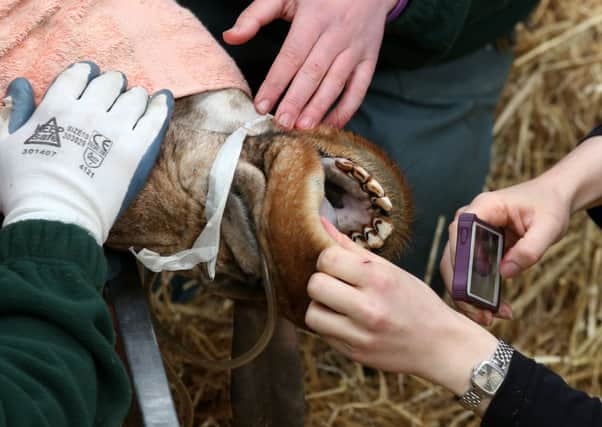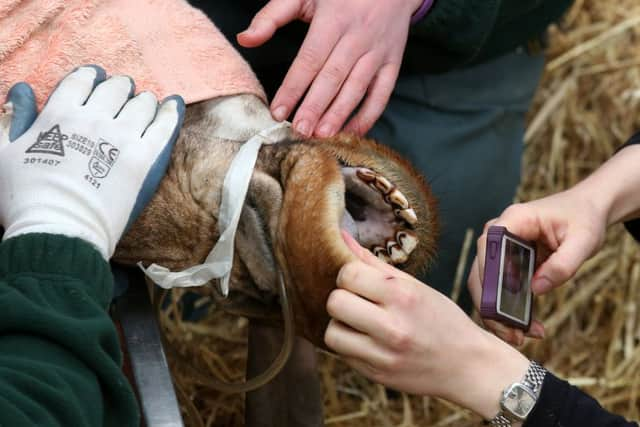Video: How a giraffe goes to the dentist


Kelly, the 14-year-old giraffe, needed a general anaesthetic to allow experts to have a look inside her mouth to check her teeth.
It comes after keepers at Blair Drummond Safari Park near Stirling noticed the animal was not digesting her food thoroughly and it was suspected she might have a problem with one of her molars.
Advertisement
Hide AdAdvertisement
Hide AdA team of around 12 vets and staff worked on the animal in the section of the park she shares with four female giraffes.


She was constantly monitored throughout the 30-minute procedure, in which an X-ray of her mouth was also taken to explore if there were any further problems with her teeth.
Using a ladder and bales of straw to prop up her long neck, veterinary surgeon Ian Rodger was able to look in her mouth where he found food being caught in a gap.
He said: “I did expect to find some changes in the mouth. I actually found a wee bit less than what I was expecting but, that said, there could still be significant sources of pain and discomfort.
“Food was becoming trapped in the gap between the teeth. The right name for that is a diastema and there were two on the lower left jaw, and I picked and cleaned and flushed them out and explored the depth of them.”
A decision was made to take X-rays of her mouth to look more closely at whether further drilling work would be required to widen the gap to avoid food continuing to be trapped there.
Mr Rodger said: “Although the changes don’t look enormous to my eye - I’ve certainly seen worse changes than that in horses’ mouths many times - gum inflammation or gum recession is a noted source of pain in an animal’s mouth, so that may well be the primary source of the problem.
“We don’t undertake general anaesthesia in a giraffe lightly but this is a problem that’s been working away for a wee while now and we felt we had no choice but to explore the mouth, and hopefully based on that and based on the X-ray, we can make some decisions as to how to put a treatment programme in place.”
Advertisement
Hide AdAdvertisement
Hide AdAilsa West, team leader for giraffes at the safari park, said: “We had noticed over the past three or four weeks that she was struggling to chew her food properly and also finding in her dung some undigested food, suggesting that she is not actually thoroughly digesting and chewing her food.
“Me and the other giraffe keepers have all been a little bit nervous about this morning, especially when you see the drug starting to take effect, but it’s so good to see her back up on her feet so quickly.”
Ms West explained some of the reasons behind giving the giraffe a general anaesthetic.
“It’s not a quick decision to make - it’s normally one of the last resorts for us, we would rather not have to do it, so obviously we have been monitoring her and trying her on pain relief and she’s not been getting better, so we needed to do it”, she said.
Staff at the safari park, which opens for the season on Saturday, monitored Kelly throughout the day yesterday before she was slowly mixed back together with the other giraffes.